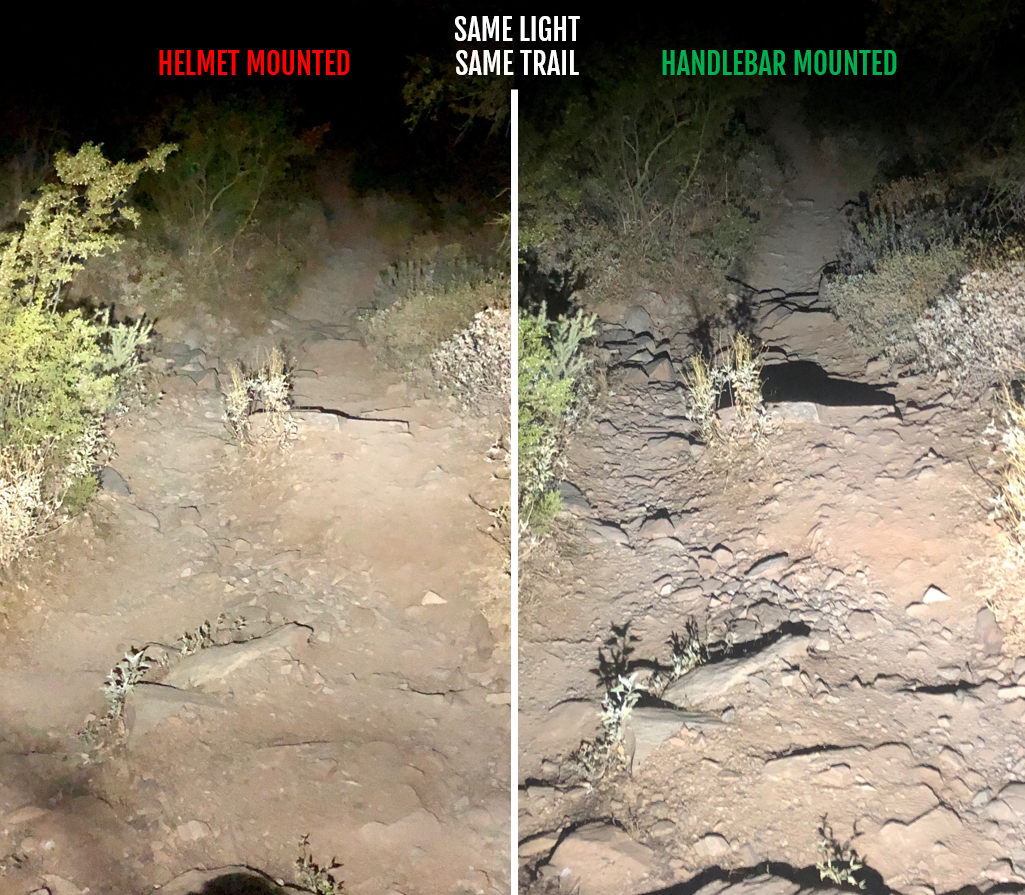Some people do put a brighter light on the helmet, but we typically don't for a number of reasons, though I will preface this with the disclaimer that there is no "wrong" answer, it's all about what you prefer and the type of terrain you ride. With that out of the way, here's why we suggest Evo on the bars and Hangover on the helmet...
First, it's not all about which is most powerful, it's about how the light is distributed. If you have a light that puts all the power into a small spot that super intense, that's going to be terrible on the bars because you're not pointing the bars where you're looking, they're pointing where they need to for the trail you're riding, so a narrow beam creates tunnel vision and a "bouncing spot" effect where you're constantly losing the trail and seeing bright flashes off the side of the trail, which is terrible for your dark adjusted eyeballs. Thus, we designed the Evo to have a much, much wider beam side-to-side with no singular bright spot and very smooth transitions so your whole field of view 180 degrees from the handlebar forward is lit up, that way when you turn the bars you don't lose the trail or get these bright reflections.
Second, a handlebar light gives the trail depth that a helmet light is physically incapable of doing. No helmet light, regardless of brand or type, will cast shadows from objects sticking out of the trail because it's above your eyeline, so the shadows are not visible, the end result being that the trail looks very flat and washed out, which is fine on smooth/buff trail, but on anything remotely chunky it makes it a lot harder to read the terrain, particularly at speed, because rocks and roots look flat to your eye. A handlebar light casts shadows out from those chunky sections of trail so that you can stare down into them, and thus give the trail visual depth, making it much easier to process mentally very quickly because it looks 3D, not 2D.
Thus, we designed Evo with a super broad, even beam on the bars to give you full peripheral vision and massive depth to the trail in front of you, and the Hangover with a narrower beam because it's going to be on the helmet where it points where you're looking, so it doesn't need to be as wide to account for pointing the wrong way. This way the Evo does the heavy lifting and provides most of your vision, while the Hangover fills in down the trail so you can spot runouts at high speed, and through tight corners. If you put a much more powerful light on your helmet, you will wash out the handlebar light and lose visual depth, making it harder to process the terrain at speed.
The secondary effect of this approach is a much more optimized setup for the rider. Because the handlebar light needs to cover a much larger area of the trail, it needs more power, and because helmet has a narrower beam, it can be more intense with less total power, and you don't want it to be too powerful or it will wash out the bar light and ruin all that depth you get. This way also has the added benefit of allowing us to make the helmet light smaller and lighterweight because it uses less power and can have less thermal mass and battery capacity, while the handlebar light can be heavier and larger battery without fatiguing you as much because it's on the bike, not on your neck.
Here's an example showing the difference made by mounting a light on the handlebars vs. the helmet. Doesn't matter what light it is, this is the same section of trail lit by the same light as viewed by the rider: on the left it's mounted on the helmet, on the right it's mounted on the bar. The left ends up looking a lot flatter than it really is because the rider can't see the shadows so the trail doesn't have any depth. Sure, some people joke "I ride faster at night because I can't see how scary the trail is" but in reality, you're going to ride faster if you can process the terrain more accurately at high speed, which is a lot harder to do without depth perception, which is what all helmet-only setups do, regardless of brand or model. If you can see out of your periphery that rock is sticking out of the ground, you'll be in a better body position and less likely to have your weight too far forward where the rock could just take the bike out from underneath you. Doesn't mean that this is the only thing that matters in a setup, but it's something to consider.

